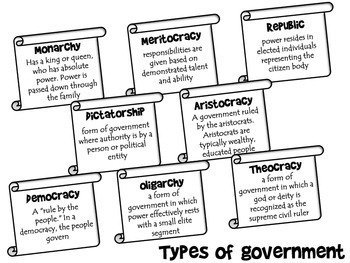Structure of Governments
Although many countries have similar institutions, the definition of those bodies and the way they work together can vary greatly. The main bodies are an executive, or head of state; a legislature; and a judiciary, or court system. Often these are defined by a constitution. In democracies the roles of these institutions are clearly defined and separated to some extent. In some countries these are all controlled by one person or a small group of people. Such countries can be mocarchies or dictatorships.
Democracy
There are two types of constitutional democracy in the world today. These are the presidential system, such as that of the United States, and the parliamentary system, such as that of the United Kingdom.
In both systems political parties are key institutions. It is through them that the citizens are able to express their opinion by voting for candidates for office. The parties are groups of people with similar views about major issues. Most candidates for political office are members of a particular party, though membership in a party means different things in different countries.
In some countries, such as the United Kingdom, the parties are fairly rigid, meaning that its members are expected to always vote with the party. In the United States, however, party members are free to vote as they see fit on any particular issue. The number of parties can also vary in each country. In some, notably the United States and the United Kingdom, there are only two main parties. In others there may be many parties. Because power is divided among more groups, it is less likely that one group will have a clear majority to rule. In such cases several parties must work together to share power.
Presidential system
In a presidential system the executive, legislative, and judicial branches are clearly separated. The president is elected by the people and is not a member of the legislature. In such systems the president is both the political head of the government and also the head of state, who presides over ceremonies and official functions. The president chooses people to serve as his or her cabinet. These are the heads of the various departments. They are not elected.
The legislature usually consists of two bodies. In the U.S. Congress, members of both the Senate and the House of Representatives are elected officials. Like the president, they are elected for set terms.
Established court systems are found in all advanced political systems. There are often several levels of courts. In the United States judges of local courts are elected by the people of a particular district. The highest court is the Supreme Court. Supreme Court justices are appointed by the president and approved by the Senate.
Parliamentary system
In a parliamentary system the prime minister is the national political leader, and another figure serves as the head of state. In the United Kingdom the head of state is the queen. In Japan it is the emperor. In some countries the head of state may be an elected president, but the prime minister usually has the true power. The prime minister is generally a member of the legislature who is either elected by the legislature or chosen automatically as the leader of the party with the most members in the legislature. The prime minister’s cabinet, and the leaders of the government departments, are also members of the legislature.
Other systems
Some constitutional countries, notably France, have systems that combine elements of the presidential and parliamentary approaches. Although France’s constitution established a parliamentary form of government, it also increased the role of the president of the republic. The constitution gives the president the power to appoint the prime minister and the executive ministers, preside over the cabinet, sign the more important decrees, appoint high civil servants and judges, and dissolve one house of the parliament. Because of this arrangement the prime minister and president must share power to a certain extent.
Monarchies
In a monarchy one person—the king or queen—has control over all parts of the government. Most countries that had been ruled by a monarch had become constitutional monarchies. In such cases the government consisted of a parliamentary system led by a prime minister. The king or queen had a very limited role as the head of state.
Dictatorships
Dictatorships can take various forms. Sometimes elected presidents and prime ministers capture power by establishing one-party rule and ending all opposition. They may continue to call the country a republic and maintain some institutions, such as a legislature, but in fact they control all the power in the country. In other cases, the military may take control. One of the major differences between democracies and dictatorships is in the role played by political parties since there are no elections in dictatorships.


No comments:
Post a Comment